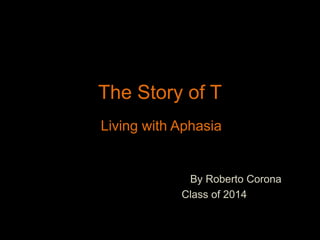Uof ch neuro
- 1. The Story of T Living with Aphasia By Roberto Corona Class of 2014
- 2. This presentation has two purposes: o To comply with the final project required in the course °∞Understanding the Brain: The Neurobiology of Everyday Life°± by The University of Chicago, through Coursera and conducted by Prof. Peggy Mason. o To serve as a tribute to my friend °∞T°± whose life changed dramatically after the accident that is described here. Sadly, at the time of °∞T°±?s ordeal, clear information was not as easily available as it is nowadays thanks to the internet.
- 3. Lectures from the course directly related to this presentation Week 3 Module 2.6 Forebrain 2.7 Visual path 2.8 Diagnosing lessions Week 4 Module 1.1 Intracranial pressure 4.1 Mass effect 4.2 Bulkheads Week 10 Module 2.1 Types of memory 4.1 Introduction to language 4.2 Aphasias
- 4. In 1998, my friend °∞T°± fell from a 3rd. floor in Mexico City. Besides several fractures in limbs and ribs, he crushed the left side of his cranium, resulting in the loss of the LEFT OPTIC NERVE which was irreparably severed, and significant lesions in the LEFT FRONTAL LOBE. Sadly, °∞T°± passed away in 2006 and during his ordeal, family and friends could only guess on the conditions he experienced, as precise information was scarce and the medical staff, either from public hospitals or private practice were unable, or unwilling, to provide clear, down to earth details which could help us understand the long term repercussions of his lesions.
- 5. During months in hospitals, unconscious and with a very swollen brain, °±T°± underwent several surgeries. A platinum plaque replaced the section of skull that was destroyed and his fractures slowly healed, eventually allowing him to walk and move at an almost normal pace. But as we were warned, his brain injuries had permanent consequences. He was diagnosed with BROCA?S APHASIA and started speech therapy four months after the accident but suspended them after one year.
- 6. Broca?s (or expressive) aphasia results from damage to BROCA?S AREA in the LEFT FRONTAL LOBE, responsible for production of language (Spoken, written or through signs).This type of aphasia is also referred to as °∞non-fluent aphasia°± because of the halting and effortful quality of speech. 1 Although it was not stated in the medical report, there were signs of damage to WERNICKE?S AREA as well. We noticed that °∞T°± had a slower comprehension to speech, and he was unable to read.
- 7. Along with everything we learned at the time from aphasia, we assumed that the lesion in the optic eye meant that °∞T°± had completely lost sight from the left eye. But, as I learned on this course, the permanent loss of the LEFT OPTIC EYE restricted °∞T°± from viewing the LEFT VISUAL FIELD OF EACH EYE, which could explain the lack of confidence he had when walking, or grabbing objects. On top of that, I doubt that he focused correctly with the left eye, since the impact crushed the rim of skull around it and a bad reconstructive surgery evidently misplaced it.
- 8. It was also evident that °∞T°± had trouble with his fine and gross motor skills, partially attributed to the severity of the fractures, but I ask myself if there was additional damage to the MOTOR CORTEX as well, or if other brain areas and functions were permanently affected as a consequence of the SEVERE BRAIN EDEMA. I cannot have access to the medical file to find out precisely the location and extent of lesions in my friend?s brain, but as I also learned in this course, our brain has the power to modify its structure not only during normal development, but in adulthood in case of traumatic events or injuries.
- 9. °∞Adult BRAIN PLASTICITY has been clearly implicated as a means for recovery from sensory-motor deprivation, peripheral injury, and brain injury°±. 2 MEMORY is one more aspect where the brain?s plasticity and strength are evident. After the first surgery, due to the brain edema, we were afraid that he would suffer of some kind of amnesia, but once he regained consciousness, slowly but gradually, the three types of memory (Working, declarative, and implicit) seemed to be almost normal. The only event he never recalled was the minutes before his accident.
- 10. The course answered a lot of questions, not only regarding my friend?s aphasia, but also in my experience with a beloved uncle who lived with polio, and recently, when I worked in a non profit center for children with various neurological disorders. Thank you, Prof. Mason and the staff of The University of Chicago for your generosity.
- 11. Sources 1 National Aphasia Association http://www.aphasia.org 2 Brain Plasticity. Prof. Ron Frostig. University of California, Irvine www.brainfacts.org/About-Neuroscience/Ask-an-Expert/Articles/2012/What-is-Brain-Plasticity
Editor's Notes
- #10: Brain plasticity (from the Greek word °Æplastos°Ø meaning molded) refers to the extraordinary ability of the brain to modify its own structure and function following changes within the body or in the external environment. The large outer layer of the brain, known as the cortex is especially able to make such modifications. Brain plasticity underlies normal brain function such as our ability to learn and modify our behavior. It is strongest during childhood °™ explaining the fast learning abilities of kids °™ but remains a fundamental and significant lifelong property of the brain. Adult brain plasticity has been clearly implicated as a means for recovery from sensory-motor deprivation, peripheral injury, and brain injury.











